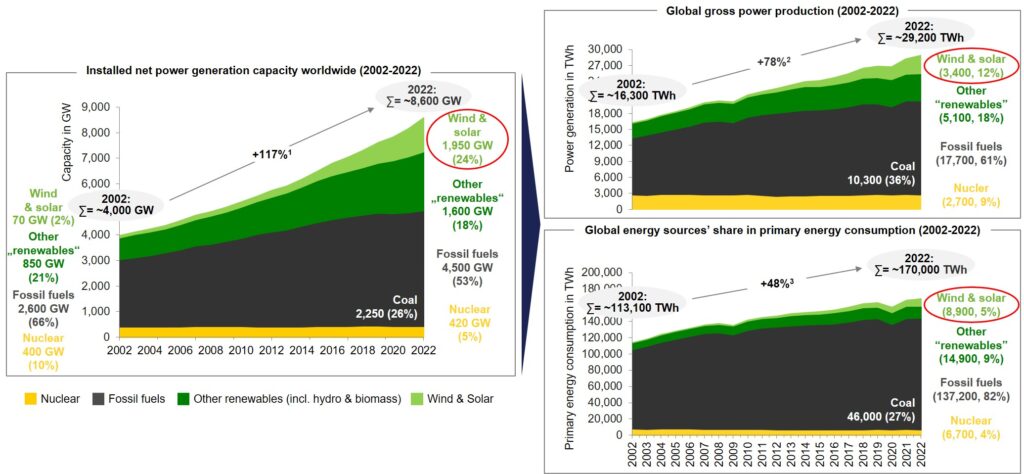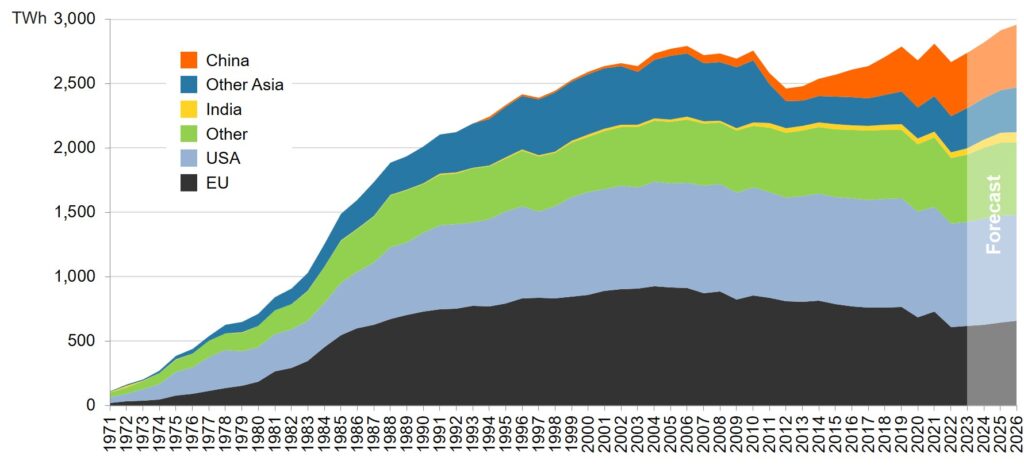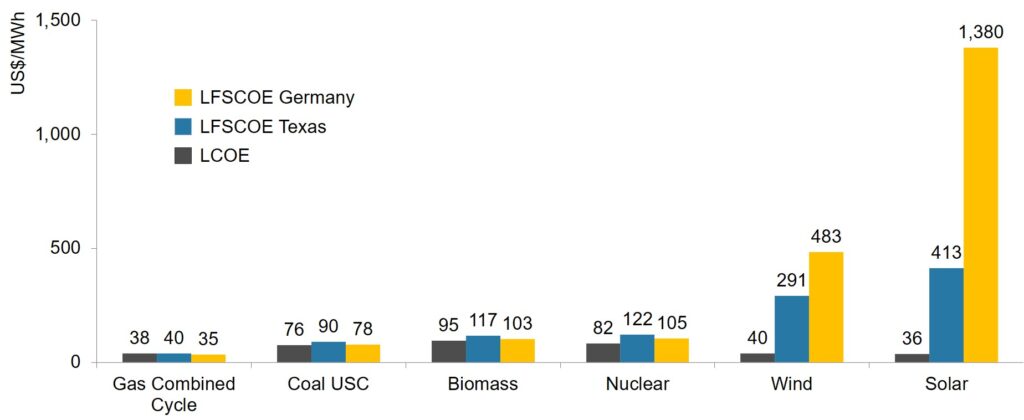By Dr. Lars Schernikau
The world’s first nuclear power plant started operation near Moscow in 1954.
The following decades saw hundreds of nuclear reactors being built around the world, with the United States, France, and China leading the build-out, making up about half of today’s global installations. About 90 per cent of today’s operating nuclear reactors were built during the 1970s and 1980s, with a global average reactor age of about 32 years. Apparently over 90% of US reactors received extensions to operate up to 60 years.
The world hosts about 420 GW of installed nuclear capacity, expected to rise to about 620 GW by 2050. Thus, today about 5% of a total of 8.6 TW of installed power capacity is nuclear.[1] The over 400 nuclear reactors contributed almost 10% of global electricity generation of about 29,000 TWh in 2022 (Figure 1). (Only about 40% of global primary energy of over 170,000 TWh is used to generate electricity; the other 60% is used for industry, heating, and transport.)
[1] IEA WEO (2023), https://www.iea.org/reports/world-energy-outlook-2023.
Note: the author writes “renewables” because they are in fact not truly “renewable” when the life cycle and raw material and energy input as well as entire environmental impact is considered. For instance hydro energy has large scale environmental impacts.
Figure 1: Global power capacity, power production, and primary energy
Sources: Schernikau based on International Energy Agency (2023),
https://www.iea.org/reports/world-energy-outlook-2023;
Energy Institute (2023), Statistical Review of World Energy, (https://www.energyinst.org/statistical-review)
Nuclear is the most net energy-efficient and raw-material-efficient source of power, with an energy return on energy investment (eROI) possibly twice or more that of coal, gas, or hydro. Nuclear is also one of the safest forms of power generation, measured in deaths per MWh generated, with the least environmental impact.
That makes it more surprising that nuclear contributes only a relatively small share of global electricity. Even more startling is the fact that nuclear’s share has continuously declined, as its build-out did not keep up with global electricity demand growth. While nuclear accounted for almost 17% of global power generation in 2002, this number declined to 9% in 2023, because absolute generation remained largely unchanged at about 2,700 TWh (Figure 2).
This might change after COP28, with 22 nations pledging to triple nuclear power by 2050. This would imply about 30 GW per year until 2050—a five-fold increase from the past decade, but in line with the boom times during the 1980s. But will this make a difference or solve the global energy problem?
Primary energy demand is likely to increase 40–50% by 2050, driven by a population increase of about 20% and per capita energy consumption growth of about 25%. Electricity demand will certainly increase faster, not only because of the current, not always energy efficient, push to ‘electrify everything’. It is therefore obvious that nuclear will contribute to this growth. However, in absolute terms, other sources—most likely dispatchable coal and gas, but also, if direct and indirect subsidies continue,[2] intermittent wind and solar—will make up the majority of capacity growth.
[2] Global average subsidies for wind and solar per MWh are far higher than subsidies for coal, gas, or nuclear— https://robertbryce.substack.com/p/actually-solar-is-getting-302-times?publication_id=630873&utm_campaign=email-post-title&r=79kdr; www.unpopular-truth.com.
Figure 2: Global nuclear power generation
Source: IEA Electricity 2024 (https://www.iea.org/reports/electricity-2024)
FUEL AND TECHNOLOGY
Uranium is abundant globally, in granitic rocks and dissolved in the ocean, but not all of it is viable for use in energy generation. In theory, the amount is easily sufficient to supply all human energy requirements. However, there are concerns about getting access to sufficient uranium, enriched uranium, and nuclear fuel assemblies.[3] Over 50% of commercially viable uranium resources are found in Australia, Kazakhstan, and Canada;[4] Kazakhstan mines over 40% of the world’s uranium. The United States now depends entirely on uranium imports, and even Russia consumes twice what it produces.
A serious concern about fuel availability may throw shadows over some exciting technological advances, such as fourth-generation reactors or small nuclear reactors, or may encourage further funding for thorium reactors. The world’s first fourth-generation high-temperature gas reactor nuclear power plant—which contains a pebble bed reactor, run by the China National Nuclear Corporation—started operating at the end of 2021. [5] Thorium-based nuclear power promises various advantages, including better fuel availability, higher efficiencies, less waste, and low weaponization potential. Small modular nuclear reactors (SMRs) are an interesting development as they may allow more cost-efficient, standardized, high-volume mini-reactor construction. SMRs, rarely ‘small’, are usually defined as being less than 300 MW in size and may be as small as 5 MW; they could generate thermal and/or electrical power. There are currently probably around 70 SMR projects worldwide in development. SMRs could be more flexible in use, and may even ramp up and down faster.
[3] Nuclear News Wire (2023), on the verge of a crisis, https://www.ans.org/news/article-4909/on-the-verge-of-a-crisis-the-us-nuclear-fuel-gordian-knot/.
[4] World Nuclear Association.
[5] Global Times (2021), https://www.globaltimes.cn/page/202112/1242878.shtml.
COSTS
Current nuclear power plant costs vary as widely as the time it takes to build one. US$2–13 million per MW and 4–25 years are the widely known ranges. While 40% of nuclear power plants were built within six years, mostly in China, the lowest-cost plants are built in China, India, and South Korea. The most expensive ones stand or will soon stand in the United States and the United Kingdom. The high cost and construction delays in the West stem primarily from regulation—which, in the author’s opinion, cannot be justified economically or scientifically. It is hoped that the recent increase in support for nuclear, as demonstrated in COP28, may change this.
At full system cost (full cost of electricity, FCOE, or levelized full system cost of electricity, LFSCOE), nuclear is likely the most expensive of all conventional or dispatchable ways of generating power (Figure 3). Yet it is still significantly cheaper than wind and solar and offers negligible emissions. However, the stated levelized cost of electricity (LCOE), a marginal cost measure, of wind and solar is very low.
Note: The author supports Idel’s principle of full system cost and its impact on wind and solar costs compared to dispatchable power from nuclear, coal, or gas[6], USC = Ultra super critical, LCOE = Levelized Cost of Electricity, LFSCOE = Levelized Full System Cost of Electricity
[6] The author does not support Idel 2022 numbers for coal and gas, as coal, on average, has lower costs than gas. For instance, BloombergNEF recently confirmed that coal is lower cost than gas, but the actual cost differ by country, BloombergNEF (2023), https://about.bnef.com/blog/cost-of-clean-energy-technologies-drop-as-expensive-debt-offset-by-cooling-commodity-prices/.
Figure 3: Full system cost of nuclear vs alternatives
Sources: Bank of America, https://advisoranalyst.com/wp-content/uploads/2023/05/bofa-the-ric-report-the-nuclear-necessity-20230509.pdf, based on Idel (2022), https://www.sciencedirect.com/science/article/pii/S0360544222018035
The claim that renewable energy from wind and solar is cheap and comes without environmental consequences is a crucial and detrimental energy-economic misunderstanding. LCOE is not appropriate for use in comparing intermittent sources of power with dispatchable ones.[7] LCOE is a microeconomic instead of total system view, excludes seven cost categories (listed below), and therefore will never be an accurate indicator for governments to base energy policy decisions on. It does not consider or account for intermittency, low natural capacity factors, correlating wind and solar availability across continents, and the locational disparity of demand and supply.
Obvious costs omitted from LCOE include the following:
- Backup or long-duration energy storage—wind and solar require at least 100% backup or storage for every installed MW. This is due to energy losses in backup and storage systems as well as the fact that usually more than one backup/storage system is required, for instance for short and long-duration energy storage.
- Network integration—this includes costs for transmission, distribution, balancing, and conditioning.
Not so obvious costs omitted from LCOE at grid scale include the following:
- Efficiency losses—more wind and solar means less asset utilization of backup or grid systems.
- Room costs [8] or space requirements—these are driven by low energy density (per m²) of wind and solar. There is an economic and environmental cost to utilizing thousands of km² to capture the diffuse energy from the sun and wind.
- Recycling costs—these are driven by the low energy density (per kg) and short lifetime of wind and solar.
- Environmental costs during operation—these include the damage to plant and animal life and negative effects on climate systems from power generation, including from warming, wind extraction, and atmospheric changes.
- Raw material and net energy inefficiency along the entire value chain—this includes production, processing, transportation, upgrading, manufacturing, and recycling, and the environmental impacts independent from the power generation itself.
If one considers the above-mentioned network integration, backup/storage, operational lifetime, energy density, and (of course) intermittency issues, then wind and solar are in fact by far the most expensive. In reality, wind and solar’s full system cost rises exponentially with higher penetration levels in the system, which has been indirectly confirmed by the Organisation for Economic Co-operation and Development OECD, International Energy Economics Institute IEEJ, International Energy Agency IEA, and other energy economic institutions.[8]
[7] Schernikau (2024), https://www.eurasiareview.com/17012024-the-energy-trilemma-and-the-cost-of-electricity-oped/.
[8] Schernikau et al. (2022), https://dx.doi.org/10.2139/ssrn.4000800.
CONCLUSION
It appears that the COP28’s push to advance and support nuclear power globally is the right thing to do. A lot of potential remains with much larger nuclear penetration globally. A pledged tripling of nuclear from 2022 (2,700 TWh or 9% of about 29,000 TWh globally) would translate to about 8,000 TWh of nuclear by 2050. If the electrification continues, the International Energy Agency’s World Energy Outlook 2023 estimates 50,000 TWh global electricity generation by 2050. Thus, nuclear’s share would then increase to just over 15%, still shy of its 17% share in 2002.
Thus, from a macroeconomic point of view, there is no realistic scenario in which nuclear will suffice to meet the growing energy demand of the next 30 years, because of (1) timing, (2) costs and regulation, and (3) the sheer volume of energy demand growth. The sobering unpopular truth is that, even if COP28 nuclear targets are met, which is necessary but still a stretch, it will only satisfy a fraction of the energy demand growth until 2050, and we will require oil, coal, gas, hydro, “renewables”, and all other reliable forms of energy-dense supply to make up the rest.
To read this article in the Oxford Institute For Energy Studies, Issue 139, Quarterly Journal for Debating Energy Issues and Policies CLICK HERE
About the Author
Dr. Lars Schernikau – With two decades immersed in the commodity industry, his journey began at The Boston Consulting Group in the USA and Germany from 1997 to 2003, shaping his deep understanding of global markets. Lars also managed a Germany based wind farm from 2003 to 2006. As a co-founder, shareholder, and former board member of the supervisory board at both HMS Bergbau AG (www.hms-ag.com) and IchorCoal NV – German-based, publicly listed, international commodity marketing and mining companies.
Lars´ experience spans across Europe, Asia, Africa, and North America. He has founded, steered, and advised enterprises across the global raw material sector, leaving a lasting imprint. Currently, Lars directs his expertise towards further enhancing HMS’ global commodity operations and driving energy and commodity marketing across Asia, Africa, the Americas, Europe and the Indian subcontinent. Notably, HMS has been a key player in coal, ore, and cementitious product markets since 1995. The company develops and operates various logistics and mining assets.
Beyond the commodity business, Dr. Schernikau is a renowned energy economist and keynote speaker at global energy and commodity forums world-wide. His counsel on macro and energy economics extends to governments, banks, educational institutions, and conglomerates, shaping energy policies. With
published books, scientific research, and press articles on energy policy and raw materials, his insights are held in high esteem. Lars has also peer-reviewed energy related books and research paper. His latest book, The Unpopular Truth… about Electricity and the Future of Energy discusses the energy transition and how to meet global growing energy demand from an energy economic point of view.



